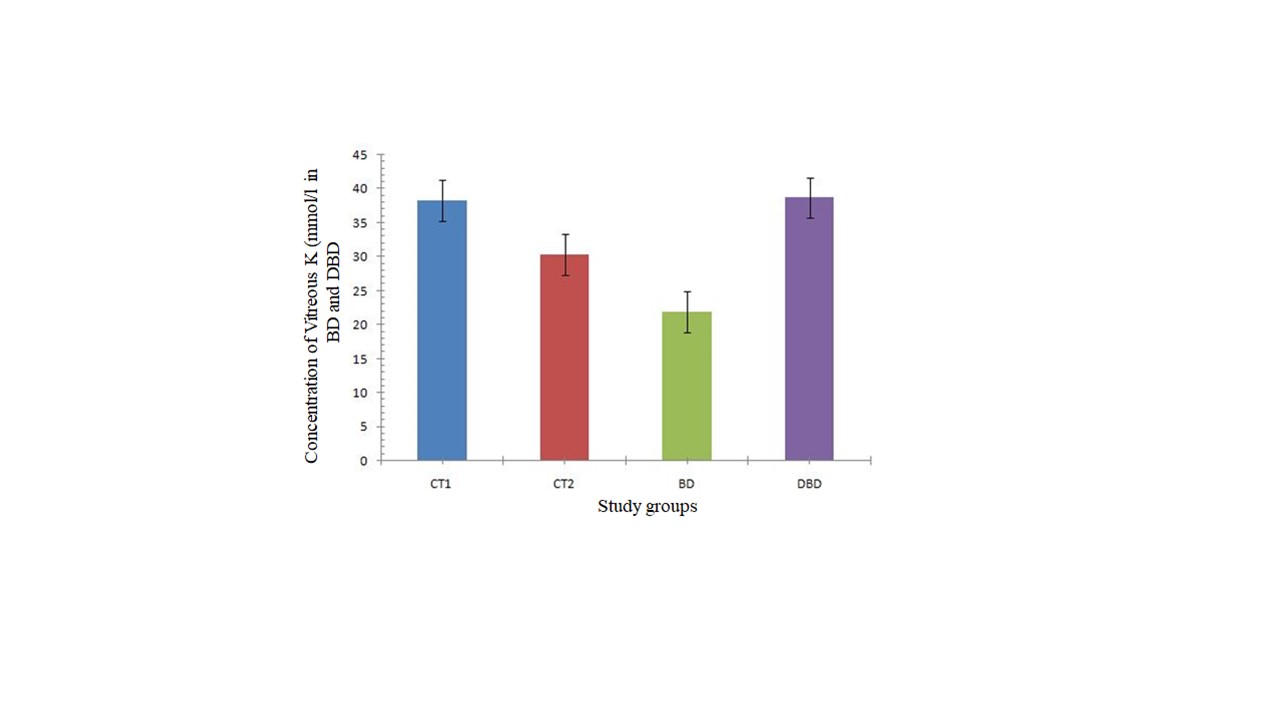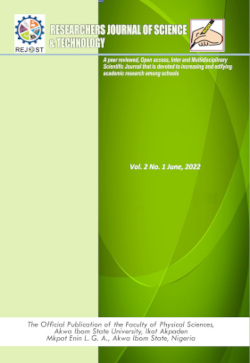Thanatochemical Utility of Postmortem Vitreous Biochemical Parameters in the Discrimination of Deaths Connected with Bleach Toxicity using Animal Models
Keywords:
Autopsy, Disguise, Discriminate, Bleach toxicity, CourtAbstract
The vitreous, unlike blood which putrefies shortly after death, promises to be a viable alternative specimen in the chemistry of death but there are no vitreous-based biomarkers for distinguishing amongst the emerging common causes of deaths. This has created a diagnostic gap that is being exploited to mask homicide as the court finds it difficult to accurately ascertain the cause of death where there are no physical injuries, as in cases of chemical toxicities. This study aims at exploring the discriminatory potentials of selected vitreous biochemical parameters in the autopsy of death by bleach toxicity and in death disguised as bleach toxicity using rabbits. Completely randomized block design (CRBD) was used for this study. 96 male rabbits were used for this research and were structured into four groups of twenty-four rabbits each: two treatment (test) groups and two control groups. In one test group, the death of the experimental subjects was caused by bleach toxicity. In the second test group, the death of the experimental subjects was caused by strangulation, thereafter, the dead subjects were administered lethal doses of bleach as a cover up of the actual cause of death. The remaining two groups are the baseline controls. After a postmortem interval of twenty-four hours, vitreous samples were obtained from each group of the experimental animals by Coe and Tente’s methods. The samples were analyzed for the levels of Sodium, Potassium, Carbon iv oxide, Chloride and Calcium using ion selective electrode method, while Total protein, Albumin, Globulin, Glucose, Total cholesterol, Triacylglycerol, Urea, Creatinine, Uric acid, Creatine kinase and Lactate dehydrogenase were analyzed using their specific standard methods. Results obtained were then analyzed with the Statistical Package for Social Sciences (Version 18-21) and one-way ANOVA (Post Hoc-LSD). The results show that postmortem vitreous levels of Na, K, Cl, total protein, creatinine and lactate dehydrogenase differed significantly (P≤0.05) between samples from deaths caused by bleach toxicity and deaths by strangulation but disguised as bleach toxicity. The striking differences in the levels of these notable analytes can be utilized either as primary or confirmatory tests to reveal and discriminate between death disguised as bleach toxicity and death by actual bleach toxicity.
References
Adam, N. and Gail, C. (2013). Postmortem Toxicology, “In Clarke’s Analytical Forensic Toxicology”. 2nd edition, PhP Pharmaceutical press, 189-213
Agoro, E.S. (2018). Urine composition. Clinical importance of urinalysis. Semed productions Port Harcourt, 26 - 27.
Agoro, E.S., Akubugwo, E.I., Chinyere, G.C. and Samuel, R. (2017d). Comparison of Vitreous Protein Profiles of Rabbits subjected to Acute Carbon Monoxide poisoning and normal animal after death. J Forensic Sci Res., Vol. 1: 040-045.
Agoro, E.S., Chinyere, G.C. and Akubugwo, E. I. (2020). Emerging concept of vitreous concentrations of proteins and lipids as discriminant of fresh water drowning death. Journal of forensic and legal medicine, Vol. 73: 1019 - 1904.
Agoro, E.S., Ikimi, C.G. and Edidiong, T. (2021). The use of vitreous renal chemistries in the discrimination of postmortem fresh water drowning. Toxicology research and application, Vol. 5: 1-6.
Agoro, E.S., Okoye, F.B.C., Azuonwu, O. and Ebiere, N.E. (2017a). The Effect of Age and Sex on Vitreous Humour Chemistry and Postmortem Interval (PMI). Indian Journal of Forensic Medicine and Toxicology, Vol. 2(2): 173-177.
Agoro, E.S., Wankasi, M.M. and Azuonwu, O. (2017b). The Forensic Application of Vitreous Humour Biochemistry in Postmortem Disease Diagnosis. Indian Journal of Forensic Medicine and Toxicology, Vol. 1: 195-199.
Agoro, E.S., Wankasi, M.M. and Ombor, J.O. (2019). Biochemical patterns of cardio-renal biomarkers in serum and vitreous humour of rabbits after chronic CO exposure. Annals of environmental science and toxicology. Vol. 3(1): 001-006.
Agoro,E. S., Okoye, F.B.C., Onyenekwe, C.C., Azuonwu, O. and Ebiere, N.E. (2017c). Extrapolation of Three Hourly Post-Mortem Interval using some Vitreous Chemistry Parameters. Journal of Forensic Research, Vol. 8(1): 1-5.
Amith, M. (2005). Role of vitreous humour biochemistry in forensic pathology. A thesis submitted to the University of Saskatchewan. (https://ecommons.usas-k.ca/handle). Retrieved 17/02/2021.
Arevalo-Silva, C., Eliashar, R., and Wohlgelernter, J. (2006). Ingestion of caustic substances: a 15-year experience. Laryngoscope. Vol. 116: 1422–1426.
Bolarin, D.M. and Azinge, E.C. (2010). Chemical pathology laboratory tests in pregnancy. Journal of medical laboratory science; Vol. 19(1): 3-13.
Bruch, M. (2007). Toxicity and safety of topical sodium hypochlorite. Contrib Nephrol. Vol. 154:24–38
Chung, I., Ryu, H., Yoon, S. and Ha, J. (2022). Health effects of sodium hypochlorite. Review of published case reports, Vol. 37(1): e20022006.
Coe, J. I. (1993). Postmortem chemistry update. Emphasis on forensic application. American Journal of Forensic Medicine and Pathology, 14(2): 91–117.
Davids, P., Bartelsman, J., and Tilanus, H. (2001). “Consequences of caustic damage of the esophagus". In: Ned Tijdschr Geneeskd. Vol: 145:2105–2108.
EPA (2001). Toxicological review of chloroform. (CAS No. 67-66-3). United States environmental protection agency. Vol. EPA/635/R-01/001: 3-9.
Farhana, A. and Lappin, S. (2023). Biochemistry, lactate dehydrogenase. Stat Pearls, Treasure Island (FL). Retrieved from https://www.ncbi-.nlm.nih.gov/books/NBK557536. Accessed on 01/06/2023.
Garg, V., Oberoi, S.S., Gorea, R.K. and Kiranjeet, K. (2004). Changes in the concentrations of vitreous potassium with increasing time since death. Journal of Indian Association of Forensic Medicine, Vol. 26: 136–139.
Gwaltney-Brant, S.M. (2022). Chlorine bleaches. MSD veterinary manual. University of Illinois. Retrieved from www.msdretmanual.com. Accessed 06/06/2023.
Gwon, A. (2008). The rabbit in cataract surgery. Tsonis, P.A. (ed.) Animal models in eye research. Elsevier, pp. 184-204.
Hifumi, T., Yoshioka, H., Kanemura, T., Kiriu, N., Hasegawa, E., Kato, H. and Koido, Y. (2010) Case of alkaline esophagitis due to sodium hypochlorite ingestion. Chudoku Kenkyu, Vol. 23 (4): 293-296.
Ikimi, C. G., Ezekwessili-Ofili, J.O. and Igwilo, I.O. (2023). Potentials of selected vitreous biochemical parameters as biomarkers in postmortem determination and discrimination of death by hanging using animal models. International Journal of Basic Science and Technology. Vol. 9(4): 204 – 211.
Ikimi, C. G., Ezekwessili-Ofili, J.O. and Igwilo, I.O. (2024). Discriminatory potentials of vitreous electrolytes and renal indices in the autopsy of deaths suspected to disguise by hanging in rabbits. International Journal of Basic Science and Technology. Vol.10(1): 33 – 34
Khorasani, A.G., Erfantalab, P. and Rezai, M. (2017). Predictive factors of gastro-intestinal injuries after exposure to sodium hypochlorite. Iranian journal of toxicology. Vol. 11(3).
Kirkwood, J. and Robert, H. (2010). The UFAW Handbook on the Care and Management of Laboratory and Other Research Animals. Wiley- Blackwell. pp. 29.
Kuiper, J., Groeneveld, A. and Slutsky, A. (2005). Mechanical ventilation and acute renal failure. Crit Care Med. Vol. 33: 1408–1415.
Martz, S.V., Wittwer, M., Tan-lin, C., Bochet, C.G., Brackmann, M. and Curty C. (2022). Influence of chlorinating agents on the formation of stable biomarkers in hair for the retrospective verification of exposure. Vol. 94(48): 16579-16586.
Omelianchuk, A., Bernat, J., Caplan, A., Greer, D., Lazaridis, C., Lewis, A., Pope, T., Ross, L.F. and Magnus, D. (2022). Revise the uniform determination of death act to align the law with practice through neurorespiratory criteria. Neurology, Vol. 98 (13): 532 – 536.
Park, J.S., Min, J.H., Kim, H. and Lee, S.W (2011). Esophageal perforation and mediastinitis after suicidal ingestion of 4.5% sodium hypochlorite bleach. Chin toxicol, Vol. 49(8): 765-766.
Peck, B., Workeneh, B., Kadikoy, H., Patel, S.J. and Abdellatif, A. (2011). Spectrum of sodium hypochlorite toxicity in man. NDT Plus, Vol. 4(4): 231-235.
Peters, T. (1996). All About Albumin: Biochemistry, Genetics and Medical Applications. San Diego, CA: Academic Press Limited.
Rosato, E., Bonelli, M., Locatelli, M., Grazia, U., Tartaglia, A., Savini, F. and D'Ovidio, C. (2021). Forensic biochemical markers to evaluate the agonal period: a literature review. Molecules, Vol. 26(11): 3259.
Ross, M., and Spiller, H. (1999). Fatal ingestion of sodium hypochlorite bleach with associated hypernatremia and hyperchloremic metabolic acidosis. Vet Hum Toxicol. Vol 41:82–86. [PubMed] [Google Scholar]
Ruchieka V., Hitesh, V. and Nirmala, N. (2014). Modified technique for soft tissue processing and staining, journal of histotechnology, Vol.37(1): 14-20.
Sacco, M.A., Cordasco, F., Scalise, C., Ricci, P. and Aquila, I. (2022). Systematic review on post-mortem protein alterations: analysis of experimental models and evaluation of potential biomarkers of time of death. Diagnostics, Vol. 12(6): 1490.
Sacco, M.A., Cordasco, F., Scalise, C., Ricci, P. and Aquila, I. (2022). Systematic review on post-mortem protein alterations: analysis of experimental models and evaluation of potential biomarkers of time of death. Diagnostics, Vol. 12(6): 1490.
Schrier, R., and Wang, W. (2004). Acute renal failure and sepsis. N Engl J. Med. Vol: 351:159–169.
Slaughter, R.J., Watts, M., Vale, J.A., Grieve, J.R. and Schep, L.J. (2019). The clinical toxicology of sodium hypochlorite. Clin toxicol. Vol. 57(5): 303-311.
Tente, W., O’Rourke, P., Sherman, S., Kauper, K., McGovern, C., Matteus, S., Dean, B., Toa, W. and Thanos, C. (2004). Sustained Delivery of hCNTF to Rabbit Vitreous Humour by Two Polymer Encapsulated Cell Lines in the NT-502 Device. Investigative Ophthamology and Visual Science Journal, Vol. 45 (13): 303 -329.
Thierauf, A., Kempf, J., Perdekamp, M.G., Auwärter, V, Gnann, H. (2011). Ethyl sulphate and ethyl glucuronide in vitreous humour as postmortem evidence marker for ethanol consumption prior to death. Forensic Science International, Vol. 210: 63-68.
Vasudevan, D.M., Sreekumari, S. and Kannan, V. (2019). Acid-base balance and pH. Textbook of medical biochemistry. 9th ed. Jaypee brothers medical publishers ltd, New Delhi, India. 444-448.
Verma, A., Vanguri, V.K., Golla, V., Rhyee, S., Trainor, M. and Abramov, K. (2013). Acute kidney injury due to intravenous bleach injection. J. Med. Toxicol. Vol. 9(1): 71-74.
Zilg, B., Alkass, K., Berg, S. and Druid, H. (2009), Postmortem identification of hyperglycemia. Forensic Science International, Vol. 185: 89-95.
Zilg, B., Alkass, K., Berg, S. and Druid, H. (2016). Interpretations of post-mortem vitreous concentrations of sodium and chloride. Forensic science international Vol. 263: 107-113.
Zilg, B., Alkass, K., Kronstrand, R., Berg, S. and Druid, H. (2022). A rapid method for postmortem vitreous chemistry analysis-deadside analysis. Biomolecules 12(32): biom12010032.

Downloads
Published
How to Cite
Issue
Section
License
Copyright (c) 2024 Researchers Journal of Science and Technology

This work is licensed under a Creative Commons Attribution-NonCommercial-NoDerivatives 4.0 International License.




